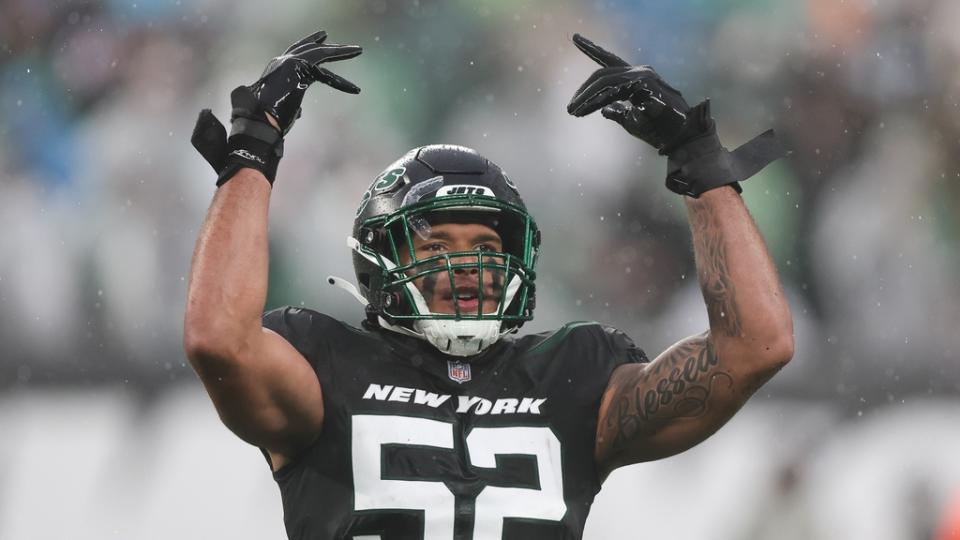What changes will Jets make to DL rotation in 2023?

The Jets’ defensive line was one of their main strengths last season, and they’re arguably even deeper in 2023 after drafting Will McDonald in the first round.
Robert Saleh’s philosophy dictates that he likes to have a deep rotation, with everyone getting plenty of time in hopes of keeping everyone fresh late in games and as the season progresses.
It's a fine balance, though. Saleh has to weigh putting his best players on the field against keeping everyone happy and engaged, while also trying to deploy his linemen in the best situations to optimize their effectiveness. With a deeper EDGE group and a couple of interesting changes at defensive tackle, we see some roles changing on the defensive line in 2023 -- but could we also see a change in approach?
Let’s first consider what they did last season. The basic plan is always to rotate players in off the bench every four plays. This isn’t always practical though. Unless a drive gets extended, they might be off the field within four plays anyway, so it’s really only when the opposing team gets a drive going that they need to rotate.
In addition, if the defense does its job on first and second down then the offense is going to be forced to pass and the rotation is essentially abandoned in lieu of getting the four best pass rushers on the field. So, a reserve might find themselves rotating in but then getting replaced within a play or two.
The Jets will also sometimes open drives with the second- or third-stringers on the field, with an ultimate goal of getting them a larger share of the reps over the course of the game.
In late-game situations where the Jets have the lead -- or on two-minute drills, at the end of the first half -- they might be in pass-rush packages all the time. This is where you are most likely to see some backups rotating into the pass rush unit.
Last year’s first unit saw Carl Lawson and John Franklin-Myers on the edge and Quinnen Williams and Sheldon Rankins inside. Rookies Jermaine Johnson and Micheal Clemons were typically the second team ends with Nathan Shepherd and Solomon Thomas inside. Vinny Curry also saw action on the edge and Tanzel Smart was activated from the practice squad a couple of times when there were injuries inside.
In pass-rush packages, the Jets initially used Lawson, Williams, Franklin-Myers and Jacob Martin. However, the emergence of Bryce Huff saw him replace Martin, who was traded at the deadline. Huff wasn’t used in the main rotation, though, so he never played any run defense. Then, towards the end of the season, the Jets started feeding Johnson some additional reps in this package and Huff’s workload was reduced accordingly.
The biggest change to the edge rotation was the selection of McDonald with the 15th pick in the draft. Could he also stake a claim to some of those situational pass-rush reps? If so, it’s possible the Jets may view Huff as expendable, and trade him as they did with Martin. Recent reports suggested they had fielded some calls about Huff, whose pressure rate was excellent in that limited role last season.
One issue with the way the rotation operates is that there was some sentiment among the reserves that they found it hard to get into a rhythm when they might only be on the field for a few plays in a row. Rankins and Shepherd opted not to re-sign, perhaps in part for this reason. Thomas, who had interest from at least one other team, did re-sign but apparently sought reassurances that he’d get more chances to run with the first unit, line up alongside Williams more often and get some opportunities on passing downs.
The Jets filled out their tackle rotation by signing ex-Seahawks Al Woods and Quinton Jefferson. Each of these could have a defined role. Woods is a massive space-stuffing run-plugger, while Jefferson is more of a pass-rush specialist. The latter could get reps in passing situations, much like Rankins did at times last season when Franklin-Myers was off the field.
There has also been some talk that the Jets could use Franklin-Myers and Clemons inside more. Franklin-Myers would typically line up inside one of the edge rushers in the Jets’ primary pass-rush packages last year, albeit usually lined up across from the tackle rather than actually on the inside. That’s unlikely to change. Clemons, who has reportedly bulked up to more than 290 pounds, actually played some rotational defensive tackle reps in preseason last year and held his own, so he could be an option to augment the interior rotation in the event of an injury.
The Jets have some excellent defensive line personnel and are developing a pipeline of young talent to eventually take on bigger roles on the edge. It will be interesting to see how they are deployed in 2023.
While Saleh’s overall philosophy is unlikely to change, a few tweaks in terms of varying up which personnel gets to play on passing downs, leaving reserve players in the game a bit longer sometimes and finding ways the increase the roles of the youngsters Clemons, Johnson and McDonald could be appropriate. This could go a long way in terms of making this group more satisfied and potentially paying off in terms of the end results.

